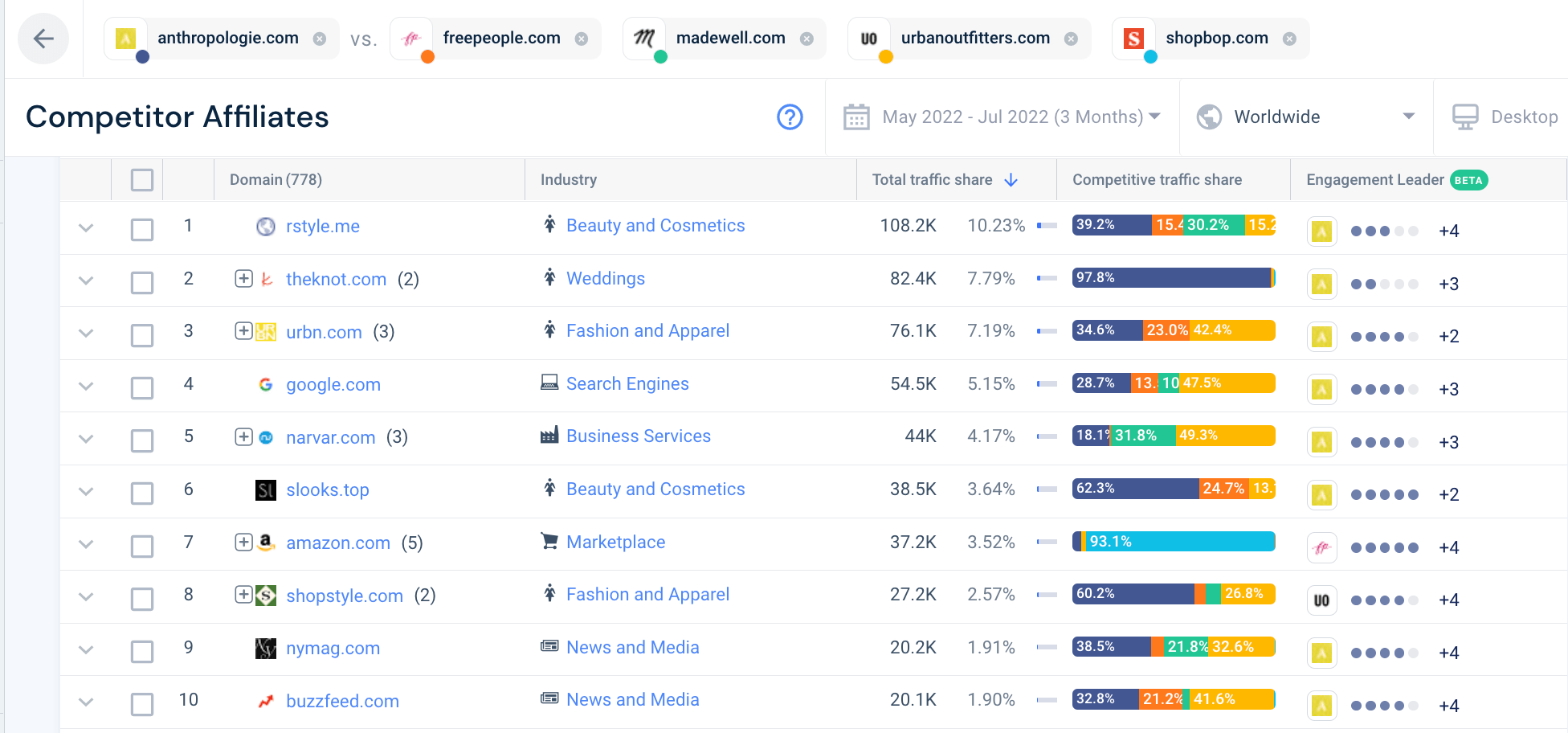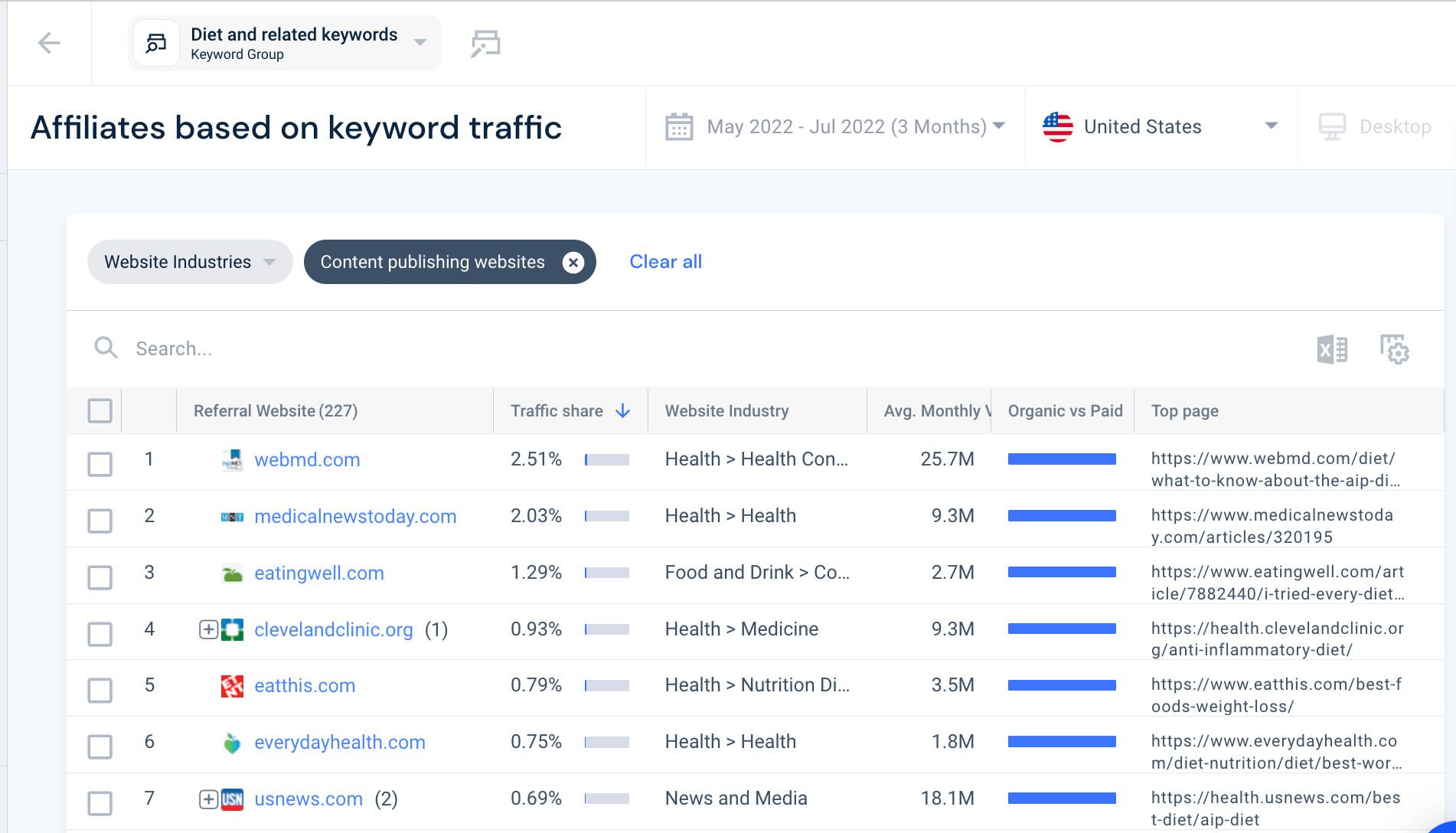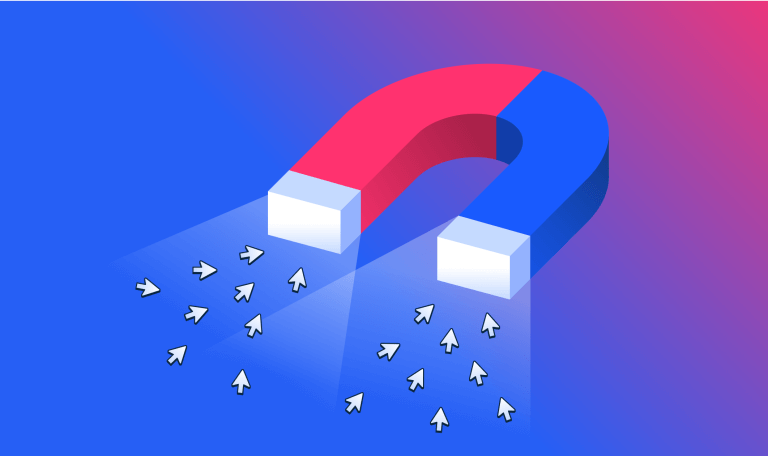Affiliate Marketing KPIs: How to Evaluate and Optimize Partnerships

Ask 25 affiliate managers to name the most important affiliate marketing KPIs, and you get 17 different answers – at least! And they all have excellent arguments to back up their choices.
The reason for such high variance is that affiliate marketing is embedded in an overall digital marketing strategy and the KPIs need to align.
What does that mean? As an affiliate manager, you’ll track many metrics as indicators for the growth of an affiliate program. Not all are indicative of the progress towards reaching marketing goals. So, define what is affiliate marketing’s role in your marketing mix.
If the main purpose is to drive traffic, you’ll focus on traffic-related metrics. Affiliate marketing that is supposed to increase sales should be evaluated by revenue-related metrics. These are your key performance indicators or KPIs.
Why you need to set KPIs for affiliate marketing
Even though affiliate marketing doesn’t require significant investment, you can still lose money or damage your company’s reputation if you aren’t on top of what’s happening.
And that’s not all. Setting KPIs allows you to be more proactive. When you are sure of what your marketing strategy needs from the affiliate marketing program, you can actively seek out high-potential partners with some dedicated affiliate research. You can also continuously optimize your affiliate program, provided your data is accurate.
So, when you read through this article explaining significant affiliate marketing metrics, keep your strategic goals in mind. Ask yourself how relevant the metric is in evaluating the efficiency of your affiliate program and the individual affiliates.
Which metrics matter for affiliate marketing?
We’ll start with the obvious metrics and then move on to the metrics that help you assess the performance of affiliates you’ve set your eyes on. See how you can discover high-potential affiliates and collect the data to make them an offer they can’t resist (or wouldn’t want to, anyway).
Metrics to measure per affiliate:
Clicks
Measuring the number of clicks an affiliate gets that send visitors to your site or landing page is fundamental. Many affiliate programs aim to increase reach, and measuring clicks is one way to assess it.
Clicks show how much exposure your product or brand gets from the affiliate. Also, for brand awareness campaigns, clicks are the first indicator of reaching a broader audience.
In most cases, clicks alone are not sufficient, though. To better gauge the affiliate’s performance, you need to weigh clicks against additional metrics, such as sign-ups or purchases. That brings us to the next metric.
Conversion Rate
Clicks without conversions don’t mean much in the long run. Conversion rate measures the percentage of clicks turned into customers. Measuring and setting goals for conversion rate is one of the most fundamental ways to evaluate your affiliates.

A high conversion rate means your affiliate is reaching the right audience. An affiliate who generates a lot of clicks but few conversions may be highly ambitious but is not reaching the right audience. The result is a low conversion rate.
But wait, don’t make it easy on yourself. The reason for a low conversion rate could be with you as well. Maybe your creatives aren’t enticing enough, or there’s some technical error.
LTV = customer lifetime value
Customer lifetime value indicates the total value an average customer brings to the company. We are talking about the accumulated order value you can expect per customer over time.
Your ideal customers aren’t the ones that use the coupon provided by the affiliate and then go back to the local store. You want customers who keep coming back and making large purchases. Measuring customer lifetime value helps you evaluate how well your affiliate succeeds in fetching valuable, loyal customers.
Setting goals for this metric helps you – and your affiliates – optimize your affiliate marketing methods and strategies. Assess which affiliate activities are more suited to attract high-value customers and which affiliates do a better job. It also helps with your affiliate program setup. Figure out how to reward the best activities and affiliates.
AOV = average order value
The average order value measures how much money a customer spends on average on a single order. You calculate it by dividing revenue by the number of orders.
Measuring the average order value has the purpose of assessing the quality of customers your affiliates bring to your site. An affiliate that sends swarms of new customers who only buy your special discount offers and never make significant purchases may not be the wunderkind you’re after. You might favor affiliates whose every referral turns into a VIP customer, even though they aren’t that many.
In a perfect world, there’s room for both, and you want to know which partner brings which audience.

Chargeback rate
The chargeback rate is another instrumental metric in evaluating the quality of customers an affiliate brings to you.
You can’t expect to never get a cashback. There’ll always be some customers that aren’t good for their money, and fraudulent activity can target anyone. However, you need to make sure that the percentage remains reasonable.
Having your eyes on the chargeback rate is good for your affiliate program’s hygiene. It helps keep the program clean of fraud and bad players. An exceptionally high cashback rate is a red flag. When you identify such an affiliate, take a closer look at what’s happening. It could also be technical glitches.

Percentage of new customers vs. returning customers
We all want new customers, and most affiliates believe their job is to attract new customers. That’s great. But if these customers never return for more, they aren’t very meaningful to your business.
The trick is to figure out the optimal ratio between new and returning visitors or users. You can define a percentage range that is “normal” for your business and that your affiliate should remain within.
Affiliate metrics to benchmark
Benchmarking is essential for your program to strive and grow. In general, you should keep an eye on your industrie’s affiliate marketing statistics to remain aware of the market leaders and see where you fit into the landscape. Industry benchmarking can also help you find your best niche for affiliate marketing.
Let’s take a look at the affiliate metrics that allow you to identify your best affiliates and decide on the steps to take to optimize your program over time.
Sales per affiliate
Identify the affiliates that drive the highest sales value. Benchmarking sales generated per affiliate is an excellent way to set targets and rewards for high performers. Keep a close eye on the top partners because they are your main value drivers. Monitoring sales per affiliate also allows you to identify new affiliates with high potential.
Year over year growth
Many affiliate managers don’t pay enough attention to this, even though the metric is insightful in so many ways.
First off, you spot your affiliate partners’ growth. Just like you need to keep growing and expanding, so do they. If the numbers of your top affiliates stagnate year over year, you need to check why.
Compare the growth rate of your affiliate partners and see who’s improving faster than others. The affiliate bringing in fewer clicks or sales than your top performer but growing at a stronger rate may be the one you want to reward and nurture.
Engagement
Appraising audience engagement allows you to assess traffic quality. The best affiliates have a loyal, trusting audience, which shows high engagement with the affiliate’s site. It’s simple math. People follow the advice and recommendation of people – or in this case affiliates – they find reliable. This is reflected in visit duration, the number of pages visited, and similar engagement metrics.
Similarweb provides an engagement score per affiliate to take the hard work off your back. The score factors various engagement metrics and presents a numeric score. Affiliates with a high engagement score are more likely to drive high-value traffic. If that isn’t the case, it could be that your audiences don’t match.
Another reason could be that the same affiliate partners with your competition and sends the most traffic there. That’s when you need to get foxy and investigate. Your competitor could be offering a better deal to these affiliates, and you need to find a way to outsmart them.

No need to check every engagement metric, Similarweb’s affiliate score lets you assess the strength of every affiliate’s audience.
Evaluate your affiliate program’s success
You want to know if and how much you benefit from your affiliate marketing program and each affiliate partnership. Measuring the right metrics helps you identify the type of activities that are most profitable. You can also try out different tactics and commission structures. In some industries recurring affiliate programs that offer a steady monthly commission rather than a one-time commission per purpose are more suited.
Revenue
Interestingly, revenue isn’t on every affiliate manager’s radar. But it should be. Even though you may not be investing massive amounts into this type of marketing, you still need to know that you are gaining from it. When you keep an eye on the revenue generated through the affiliate program, you can position this marketing channel against others.
If you are working with different types of affiliates, monitor revenue per segment. This allows you to focus your energies on the most profitable affiliate area, identify weaknesses and strengths and optimize.
Traffic quality
Many of the metrics you measure for the individual affiliate are worth tracking for the program as a whole. Evaluate overall performance and analyze the value affiliate marketing brings to your business.
Compare the percentage of new vs. returning customers, average order value, and customer lifetime. Benchmark the volume of referral traffic against your competition to get a better idea of what the numbers imply.
Top 10 affiliates
Your ten most successful affiliates are responsible for driving the largest part of quality traffic and the resulting sales. These are the affiliates to monitor closely and nurture. You want to detect when the affiliates in the top ten list change. A bit of change is a sign of healthy competition. Too much change may be a red flag.
Percentage of affiliate sales
Your marketing strategy includes a variety of digital marketing methods. When starting with affiliate marketing, you should set expectations about traffic, revenue, and cost.
Keep track of the percentage of traffic from affiliate referrals and the sales generated from that traffic.

Number of affiliates
Keep monitoring the number of affiliates in your program and correlate it with the revenue from the affiliate program. You want your program to grow at a healthy rate, and you also want to make sure not to depend on a few strong affiliates only.
Metrics to help qualify affiliate partners
You don’t have to work with just anybody, so set up a process that allows you to filter out affiliates that aren’t a good fit. Let’s look at some metrics that help you assess whether your affiliates are capable of driving the traffic and sales you desire.
These KPIs can serve as qualification thresholds for new affiliates applying to your program.
- Traffic volume – set a minimum traffic volume. You want to be sure that the site has the capacity to generate sufficient traffic to your website.
- Engagement score – target affiliates with high authority. In the long run, you want your affiliates to keep sending active, returning customers your way.
- Monthly unique visitors – this metric may even be more important than the number of visits. It tells you how many individuals visit the site in a month. If the number is too low compared to the visits, the affiliate isn’t reaching enough new visitors. If the number is too high, no one returns to the site, and that’s a bad sign.
- Audience demographics – set the basic parameters for your target audience to ensure the affiliate audience matches your target audience.

With the new vs. recurring visitors feature of Similarweb, you don’t need to calculate monthly average users yourself. The tool does it for you.
Find and recruit high-potential affiliates
To ensure your affiliate program hits its goals, you may want to develop ways to support and initiate growth. Don’t leave it to luck or pray that the right affiliates will stop at your doorstep. Go out to find affiliate marketers or companies with high potential and reach out to them.
How do you do that? The secret is to access the affiliate’s traffic data before they become your affiliate. If you want to locate partners that might be a good fit for you, there’s no better place to start than your competition.
Identify affiliate potential
Find out who your closest competitors collaborate with. Discover where they get their affiliate traffic from. The Similarweb competitor affiliate function practically does it for you.
From there, you can investigate deeper into the affiliate’s activities and performance. If they meet your expectations, and you think they could do for you what they do for the competition, reach out. Instead of digging up your competitors’ affiliate partners, simply enter competitors’ names into the Similarweb and see where they get affiliate traffic from.

Another way to find valuable partners is by searching industry affiliates. Discover affiliate sites that are active in your industry and geographic region. Check what they do and how effective their marketing activities are. Then pinpoint the ones that are a good fit for your product or brand.
Use the metrics we explained above to evaluate their potential:
- Compare the amount of traffic they provide to various players in your industry.
- Investigate if they specialize in a specific product or product category.
- Check their engagement score.
Identify potential affiliates by keyword
About 80% of affiliate marketing is done by blogging. Bloggers receive organic traffic and so do many other affiliate activities. For some businesses, identifying sites that receive relevant keyword traffic is the best way to find new affiliates.
The keyword affiliates function in Similarweb tracks down the affiliates that get lots of traffic for your top keywords. Just enter a keyword and you may be on your way to your best affiliate partnership yet. See who’s getting traffic and engagement for similar keywords and investigate where they send that traffic. You can find more potential affiliate partners based on the traffic they receive for top keywords.

Let’s wrap it up!
When you put all of the above together you’ll realize that it all boils down to two things:
- Be proactive!
Proactively
- get the insights you need to evaluate affiliate performance.
- seek affiliates with high potential.
- reach out to affiliate partners.
- initiate changes based on monitoring KPIs.
- Get reliable data!
Reliable data
- ensures that your assessments are accurate.
- is the basis for a successful strategy.
- lets you identify trends early on and act upon them.
- enables you to optimize and be proactive.
All you need now is to pick the metrics that are representative of your affiliate marketing goals and start collecting data.
The #1 affiliate marketing research tool - get started
Give it a try or talk to our marketing team — don’t worry, it’s free!







